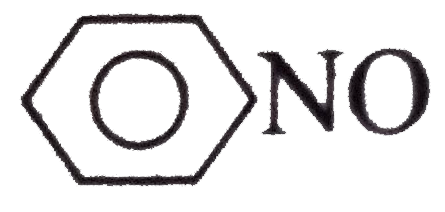Aniline is oxidized by peroxytrifluoro acetic acid in methy1ene dichloride to yield mainly .




The correct Answer is:B
To solve the question about the oxidation of aniline by peroxytrifluoroacetic acid in methylene dichloride, we will follow these steps:
Step 1: Understand the Reactants
Aniline (C6H5NH2) is an aromatic amine. The oxidizing agent is peroxytrifluoroacetic acid (CF3CO3H), which contains a trifluoroacetyl group and a peroxy group.
Hint: Identify the functional groups in the reactants and their potential reactivity.
Step 2: Reaction Mechanism
When aniline is treated with peroxytrifluoroacetic acid, the amino group (-NH2) can be oxidized. The oxidation typically leads to the formation of a nitro group (-NO2) on the aromatic ring.
Hint: Consider how oxidation affects amines and what products are commonly formed.
Step 3: Identify the Product
The primary product of the oxidation of aniline under these conditions is nitrobenzene (C6H5NO2). This occurs because the -NH2 group is converted into a -NO2 group.
Hint: Recall the common products formed from the oxidation of amines, especially in the presence of strong oxidizing agents.
Step 4: Confirm the Reaction Conditions
The reaction takes place in methylene dichloride, which is a non-polar solvent that helps in dissolving the reactants and facilitating the reaction. The presence of peroxytrifluoroacetic acid indicates that the oxidation is likely to proceed via a radical mechanism.
Hint: Think about how the solvent and conditions might influence the reaction pathway and product formation.
Step 5: Conclusion
Based on the above steps, the main product formed when aniline is oxidized by peroxytrifluoroacetic acid in methylene dichloride is nitrobenzene.
Final Answer: The main product is nitrobenzene (C6H5NO2).
---
Aniline (C6H5NH2) is an aromatic amine. The oxidizing agent is peroxytrifluoroacetic acid (CF3CO3H), which contains a trifluoroacetyl group and a peroxy group.
When aniline is treated with peroxytrifluoroacetic acid, the amino group (-NH2) can be oxidized. The oxidation typically leads to the formation of a nitro group (-NO2) on the aromatic ring.
The primary product of the oxidation of aniline under these conditions is nitrobenzene (C6H5NO2). This occurs because the -NH2 group is converted into a -NO2 group.
The reaction takes place in methylene dichloride, which is a non-polar solvent that helps in dissolving the reactants and facilitating the reaction. The presence of peroxytrifluoroacetic acid indicates that the oxidation is likely to proceed via a radical mechanism.
Based on the above steps, the main product formed when aniline is oxidized by peroxytrifluoroacetic acid in methylene dichloride is nitrobenzene.
Topper's Solved these Questions
- AMINESBOOK - R SHARMACHAPTER - AMINESEXERCISE - Follow -up Test 3
1 Videos
- AMINESBOOK - R SHARMACHAPTER - AMINESEXERCISE - Follow -up Test 4
1 Videos
- AMINESBOOK - R SHARMACHAPTER - AMINESEXERCISE - Follow -up Test 2
1 Videos
- ALCOHOL, PHENOL AND ETHERSBOOK - R SHARMACHAPTER - ALCOHOL, PHENOL AND ETHERSEXERCISE - ETHERS level IV
7 Videos
- BIOMOLECULESBOOK - R SHARMACHAPTER - BIOMOLECULESEXERCISE - Archives
47 Videos
Similar Questions
Knowledge Check
Aldoxime on oxidation by trifluoroperoxy acetic acid gives
A1∘ - aminesB2∘ - aminesC1∘ - nitroparaffinsD2∘ - nitroparaffinsKetoxime on oxidation by trifluoroperoxy acetic acid gives
A1∘ - nitroparaffinsB2∘ - nttroparaffinsC3∘ - nitroparaffinsD1∘ - aminesGlucose is oxidized by nitric acid to yield
Aglycolic acidBgluconic acidCglucaric acidDglyoxalic acid
Acetic acid is obtained by the strong oxidation of:
View SolutionAcetic acid cannot be obtained by the oxidation of
View SolutionBrominatio of PhCOMe in acetic acid medium produc es mainly :
View SolutionAldehydes are readily oxidised to yield carboxylic acids but ketones are inert to oxidation.
Which is the most likely explanation regarding this difference in reactivity?
View SolutionBromination of PhCOMe in acetic acid medium produces mainly
View Solution
